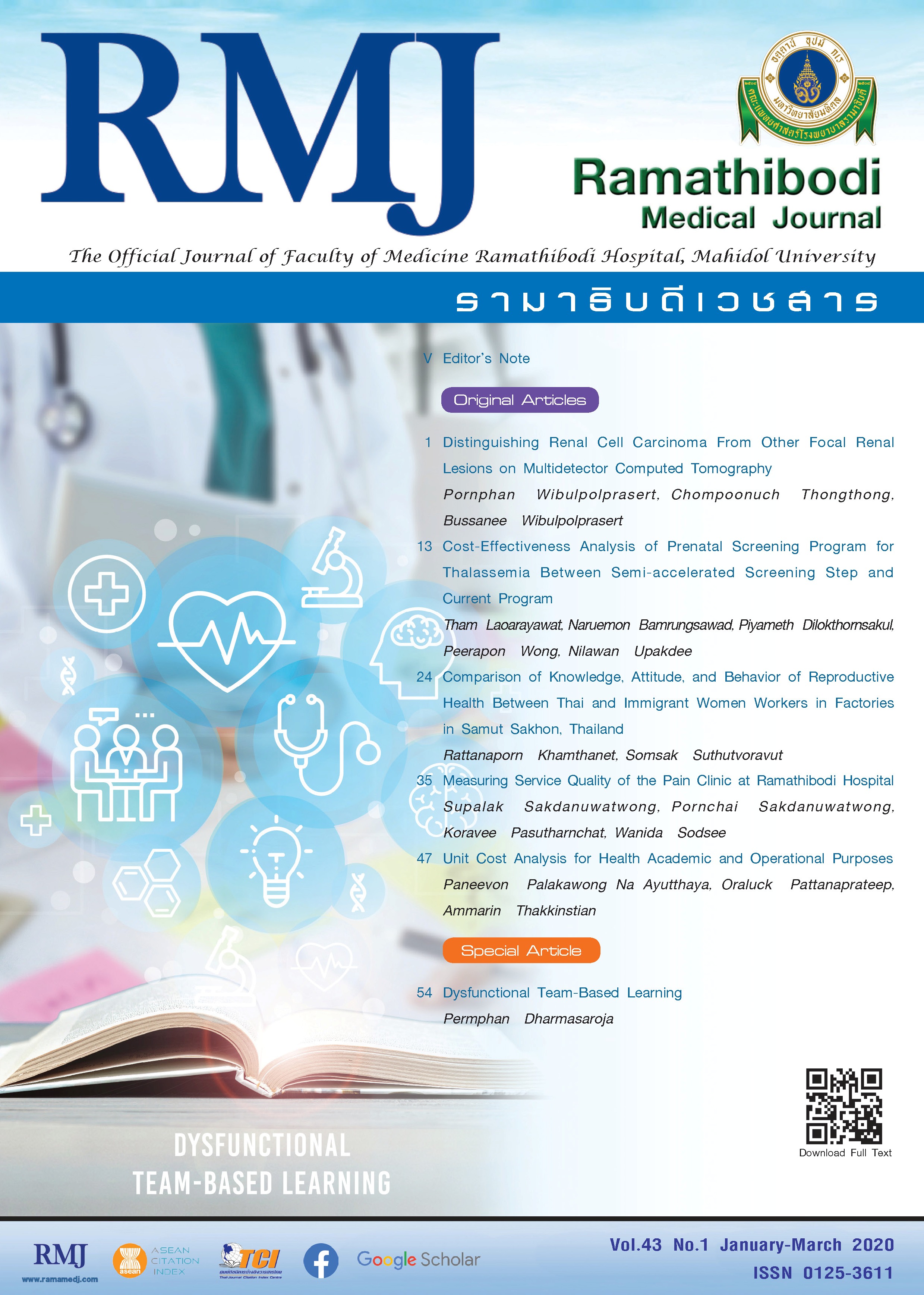Distinguishing Renal Cell Carcinoma From Other Focal Renal Lesions on Multidetector Computed Tomography
DOI:
https://doi.org/10.33165/rmj.2020.43.1.176267Keywords:
Renal cell carcinoma, Renal mass, Computed tomographyAbstract
Background: The increased use of imaging modalities has led to a greater incidence in depicting solid renal mass. These lesions comprise a wide spectrum of malignant such as renal cell carcinoma (RCC) and benign histologies.
Objective: To determine the multidetector computed tomography (MDCT) features that discriminate RCC from other focal renal lesions.
Methods: A retrospective review was performed on 148 patients who underwent renal CT scan followed by renal surgery or biopsy during January 2008 to July 2014. Specific predictive MDCT features of RCC were determined by logistic regression analysis. Interobserver agreement (kappa [K] values) was also calculated for each CT feature.
Results: In 148 pathologic proved focal renal lesions, 91 (61.5%) were RCCs and 57 (38.5%) were non-RCCs. RCCs were more likely to be in male patients (OR, 5.39; 95% CI, 2.25 - 12.90), no internal fat component (OR, 46.50; 95% CI, 5.25 - 411.90), locate at peripheral (OR, 7.41; 95% CI, 1.63 - 33.73), and mixed central-peripheral locations (OR, 26.22; 95% CI, 4.23 - 162.58) of the kidney. There was moderate-to-excellent agreement among the readers over all these features (K = 0.43 - 0.91).
Conclusions: Focal renal lesion with no internal fat component in MDCT is the most useful characteristic in differentiating RCCs from others.
References
Jemal A, Bray F, Center MM, Ferlay J, Ward E, Forman D. Global cancer statistics. CA Cancer J Clin. 2011;61(2):69-90. doi:10.3322/caac.20107.
Lindblad P. Epidemiology of renal cell carcinoma. Scand J Surg. 2004;93(2):88-96. doi:10.1177/145749690409300202.
Kovacs G, Akhtar M, Beckwith BJ, et al. The Heidelberg classification of renal cell tumours. J Pathol. 1997;183(2):131-133. doi:10.1002/(SICI)1096-9896(199710)183:2<131::AID-PATH931>3.0.CO;2-G.
Cancer Registry, Ramathibodi Hospital, Mahidol University. Ramathibodi Cancer Report 2014. https://med.mahidol.ac.th/cancer_center/sites/default/files/public/pdf/Annual_Rama_2014.pdf. Accessed January 6, 2020.
Patard JJ, Rodriguez A, Rioux-Leclercq N, Guillé F, Lobel B. Prognostic significance of the mode of detection in renal tumours. BJU Int. 2002;90(4):358-363.doi:10.1046/j.1464-410X.2002.02910.x.
Kato M, Suzuki T, Suzuki Y, Terasawa Y, Sasano H, Arai Y. Natural history of small renal cell carcinoma: evaluation of growth rate, histological grade, cell proliferation and apoptosis. J Urol. 2004;172(3):863-866. doi:10.1097/01.ju.0000136315.80057.99.
Hollingsworth JM, Miller DC, Daignault S, Hollenbeck BK. Rising incidence of small renal masses: a need to reassess treatment effect. J Natl Cancer Inst. 2006;98(18):1331-1334. doi:10.1093/jnci/djj362.
Murphy AM, Buck AM, Benson MC, McKiernan JM. Increasing detection rate of benign renal tumors: evaluation of factors predicting for benign tumor histologic features during past two decades. Urology. 2009;73(6):1293-1297. doi:10.1016/j.urology.2008.12.072.
Silverman SG, Gan YU, Mortele KJ, Tuncali K, Cibas ES. Renal masses in the adult patient: the role of percutaneous biopsy. Radiology. 2006;240(1):6-22. doi:10.1148/radiol.2401050061.
Dyer R, DiSantis DJ, McClennan BL. Simplified imaging approach for evaluation of the solid renal mass in adults. Radiology. 2008;247(2):331-343. doi:10.1148/radiol.2472061846.
Wibulpolprasert P, Jungtheerapanich S, Wibulpolprasert B. Distinguishing infiltrative transitional cell carcinoma from other infiltrative lesions of the kidneys on multidetector computed tomography. Rama Med J. 2019;42(4):1-11. doi:10.14456/rmj.2019.42.4.176646.
Davenport MS, Neville AM, Ellis JH, Cohan RH, Chaudhry HS, Leder RA. Diagnosis of renal angiomyolipoma with Hounsfield unit thresholds: effect of size of region of interest and nephrographic phase imaging. Radiology. 2011;260(1):158-165. doi:10.1148/radiol.11102476.
Silverman SG, Mortele KJ, Tuncal K, Jinzaki M, Cibas ES. Hyperattenuating renal masses: etiologies, pathogenesis, and imaging evaluation. Radiographics. 2007;27(4):1131-1143. doi:10.1148/rg.274065147.
Zhang J, Lefkowitz RA, Ishill NM, et al. Solid renal cortical tumors: differentiation with CT. Radiology. 2007;244(2):494-504. doi:10.1148/radiol.2442060927.
Kim JK, Kim TK, Ahn HJ, Kim CS, Kim KR, Cho KS. Differentiation of subtypes of renal cell carcinoma on helical CT scans. AJR Am J Roentgenol. 2002;178(6):1499-1506. doi:10.2214/ajr.178.6.1781499.
Tsili AC, Argyropoulou MI, Gousia A, et al. Renal cell carcinoma: value of multiphase MDCT with multiplanar reformations in the detection of pseudocapsule. AJR Am J Roentgenol. 2012;199(2):379-386. doi:10.2214/AJR.11.7747.
Raza SA, Sohaib SA, Sahdev A, et al. Centrally infiltrating renal masses on CT: differentiating intrarenal transitional cell carcinoma from centrally located renal cell carcinoma. AJR Am J Roentgenol. 2012;198(4):846-853. doi:10.2214/AJR.11.7376.
McHugh ML. Interrater reliability: the kappa statistic. Biochem Med (Zagreb). 2012;22(3):276-282.
Zhang YY, Luo S, Liu Y, Xu RT. Angiomyolipoma with minimal fat: differentiation from papillary renal cell carcinoma by helical CT. Clin Radiol. 2013;68(4):365-370. doi:10.1016/j.crad.2012.08.028.
Prasad SR, Humphrey PA, Catena JR, et al. Common and uncommon histologic subtypes of renal cell carcinoma: imaging spectrum with pathologic correlation. Radiographics. 2006; 26(6):1795-1806. doi:10.1148/rg.266065010.
Motzer RJ, Bander NH, Nanus DM. Renal-cell carcinoma. N Engl J Med. 1996;335(12):865-875. doi:10.1056/NEJM199609193351207.
Tsili AC, Argyropoulou MI. Advances of multidetector computed tomography in the characterization and staging of renal cell carcinoma. World J Radiol. 2015;7(6):110-127. doi: 10.4329/wjr.v7.i6.110.
Renal Tumors. In: Dunnick NR, Sandler CM, Newhouse JH, eds. Textbook of Uroradiology. 5th ed. Philadelphia: Lippincott Williams & Wilkins; 2013:126-155.
Kim JK, Park SY, Shon JH, Cho KS. Angiomyolipoma with minimal fat: differentiation from renal cell carcinoma at biphasic helical CT. Radiology. 2004;230(3):677-684. doi:10.1148/radiol.2303030003.
Hélénon O, Chrétien Y, Paraf F, Melki P, Denys A, Moreau JF. Renal cell carcinoma containing fat: demonstration with CT. Radiology. 1993;188(2):429-430. doi:10.1148/radiology.188.2.8327691.
Strotzer M, Lehner KB, Becker K. Detection of fat in a renal cell carcinoma mimicking angiomyolipoma. Radiology. 1993;188(2):427-428. doi:10.1148/radiology.188.2.8327690.
Hélénon O, Merran S, Paraf F, et al. Unusual fat-containing tumors of the kidney: a diagnostic dilemma. Radiographics. 1997;17(1):129-144. doi:10.1148/radiographics.17.1.9017804.
Obuz F, Karabay N, Seçil M, İğci E, Kovanlikaya A, Yörükoğlu K. Various radiological appearances of angiomyolipoinas in the same kidney. Eur Radiol. 2000;10(6):897-899. doi:10.1007/s003300051031.
Hosokawa Y, Kinouchi T, Sawai Y, et al. Renal angiomyolipoma with minimal fat. Int J Clin Oncol. 2002;7(2):120-123. doi:10.1007/s101470200016.
Milner J, McNeil B, Alioto J, et al. Fat poor renal angiomyolipoma: patient, computerized tomography and histological findings. J Urol. 2006;176(3):905-909. doi:10.1016/j.juro.2006.04.016.

















